
 |
|||||
|
|
|||||
|
|
|
|||||
|
|
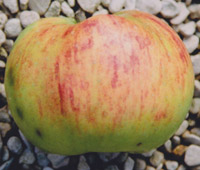 |
NONSUCH – or Nonesuch, is a very important apple, first mentioned by Ray in 1668 and last noted by Bunyard in 1920. An accession in the National Collection was discarded a few years ago as being ‘false’. Although trees might still exist across the land, no sightings of it have been made in Britain or elsewhere. We then found ‘Old Nonesuch’ listed in the collection of Nick Botner in Oregon. In 2010 we received scions and though our new trees have not yet fruited, we would not want anyone deprived of the opportunity of having one, until our next catalogue. It remains to be seen if this is indeed the old, ‘lost’ Nonsuch. 17th and 18th century writers called this a winter storing apple, but Forsyth (1810), Lindley (1831) and Hogg (1884) suggested the variety then known was ripe in September/October and not lasting beyond December. Perhaps different climates accounted for it, but there was uncertainty if the same apple was being described. In 1886, Barron described another, larger and mid season apple under this name. It has been variously described as ‘good at the table and well marked for cyder’, ‘for culinary purposes’ and ‘dual purpose’. It has generally been agreed that this is a medium sized, very showy apple, held in high regard. Its age can only be guessed at - but nearly 350 years old, at least. Pollination Group 4 |
||
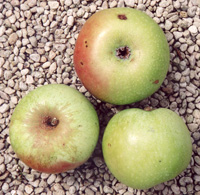 |
NORADA A good apple, sent to us by the late Kate Collins, of Ingham, Norwich, Norfolk. In her garden orchard is a very old fallen tree, which has sent up a new vertical trunk. The variety is quite unknown and was named by Kate as ‘Norada’. Her father, Percy Collins, a boat builder, once owned the tree and ‘Norada’ was his favourite boat. The apples are pale green with prominent lenticels and often with a brown red flush, which fades when fully ripe and the whole apple turns pale yellow. Round and regular in form and slightly flattened, it is a medium sized cooking apple. It cooks to a purée quickly. Kate recommended just a little sugar and cinnamon for a delicious sauce. We concur! A late season apple, storing until the end of the year. Pollination Group 3 |
|||
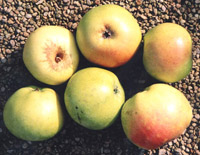 |
NORFOLK
BEAUTY A large culinary apple introduced in 1902 by a Mr Allan
of Gunton Park, Norwich. The pale cream flesh breaks up completely when
cooked, having a rich and tangy flavour. Trees are vigorous and spreading
trees, very hardy and part tip bearing. Ripe in late September, the apples
will store until December. Pollination Group 3 |
|||
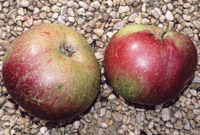 |
NORFOLK
BEEFING Originating in Norfolk and first recorded under the name
Norfolk Beiffin in 1732, it probably dated from before 1698, under names
such as Biffin, Beffin, Beaufin etc. It is a culinary or dessert apple
with very firm flesh. It can be slow to soften when cooked and remains
firm but with a rich flavour. By December the apples are sweet enough
to eat uncooked. Norfolk Beefings were also used for drying and make delicious
crystallised apple slices. The trees are hardy, with attractive blossom.
Ripe in November, the apples will last until April. It is an old apple,
useful in times when they needed to be stored. While it is very good,
there are better eating and cooking apples to be chosen, unless storing
is important. T*. Pollination Group 4 |
|||
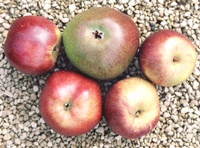 |
NORFOLK
COLEMAN A variety much confused over the years with Norfolk Beefing
and Winter Colman, though the suspicion is that all three were separate,
though similar, apples. Unpicking the correct references in the histories
is now difficult, but the first reference to Norfolk Coleman was in 1810,
from Forsyth. It was in the London Horticultural Society collection in
1826. Forsyth said ‘The Norfolk Colman is a middle-?ized Apple of
a mahogany colour towards the ?un, and a dark-green on the other ?ide.
It keeps till Augu?t’, meaning the following year. It is doubtful
that the apple now known, in the current climate, will keep quite that
long. It is a useful dessert apple, sweet and fragrant when fully ripe,
with dense flesh and a thick skin, both good indicators of good storing
ability. Kindly sent to us by John and Helen Hempsall of East Markham,
Nottinghamshire. Pollination Group 3 |
|||
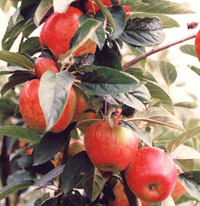 |
NORFOLK
ROYAL A mid-season dessert apple found as a chance seedling in
1908 at Wright's Nurseries in Norfolk. Very showy fruit, with a shiny
red flush which sometimes extends all over the fruit, with streaks of
darker red and sweet, juicy, crisp flesh. The white flesh is sometimes
streaked with pink, and is richly flavoured. The apples are usually ripe
in late September and will keep until December. The trees are moderately
vigorous, with large pink flowers and heavy crops. Part tip bearing, but
generous with spurs. Pollination Group 4 |
|||
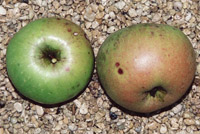 |
NORTHERN
GREENING First mentioned in 1802, but it is believed to be much
older. The smooth-skinned, bright green apples, often flushed bronze red
and sometimes striped, were popular all over the north and Scotland for
apple sauce, sweet and very rich, throughout the 19th century, storing
well until April. The flesh often has a slight pink/red blush under the
skin. The vigorous trees crop well. Pollination Group 5 |
|||
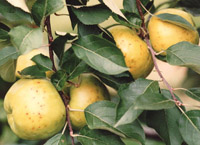 |
NOTTINGHAM
PIPPIN Existing before 1815, it is a medium sized dessert apple
that was also known in Europe and America in the early 19th century, but
it is now rarely seen. It is a regular and abundant cropper with green
skin, ripening to lemon yellow, with a few russet patches and no trace
of red. The flesh is white, tender, sweet, juicy and vinous. In season
from November to February according to Hogg, though it is usually ripe
earlier. In mid November the flesh is firm and crumbly, rather than crisp,
with a sweet and pleasant flavour. Pollination Group 4 |
|||
 |
NUTMEG
Nutmeg Apple was included in Richard Weston’s “The Gardener’s
and Planter’s Calendar” of 1773, as being ripe in November
and December. Nutmeg was listed by Forsyth in 1801 and was in the London
Horticultural Society collection in 1842. There is no suggestion that
any were referring to Nutmeg Pippin and some evidence to suggest they
were not. There are no further accounts of this apple after. This apple,
found in America, and now with us, is not the same as Nutmeg Pippin. As
Weston suggests, it is ripe in November. A pretty little apple, with skin
of gold, liberally washed with pink-red and with fine textured flesh which
is very juicy, sweet, rich and unusually flavoured. The taste is spicy,
ephemeral and sometimes hard to catch. A good and probably very old apple.
Pollination Group 4 |
|||
|
||||